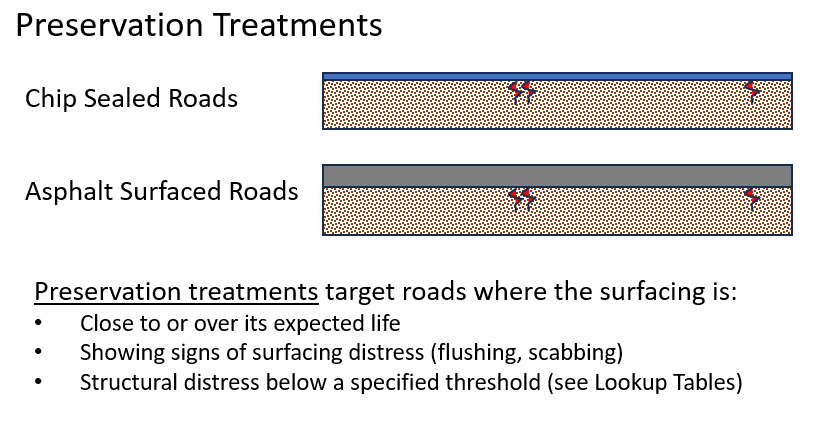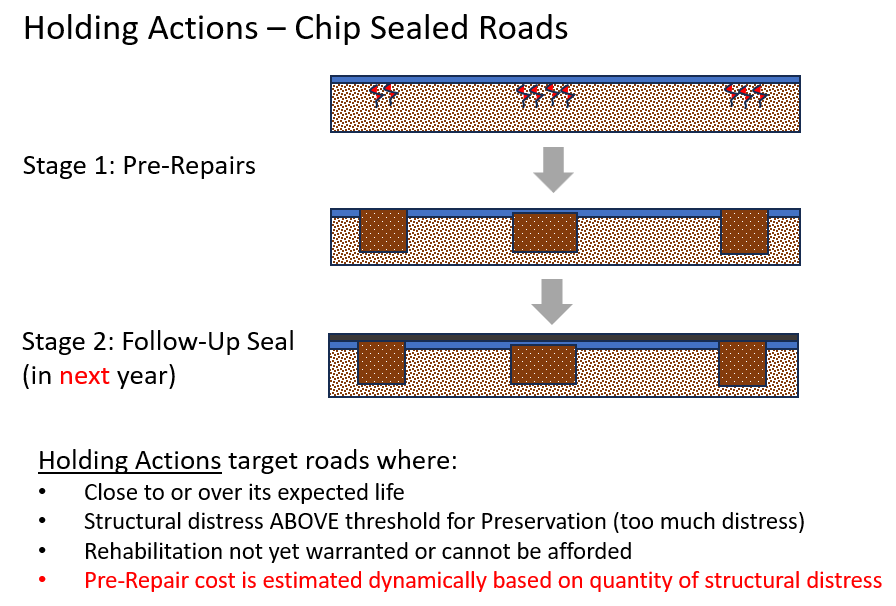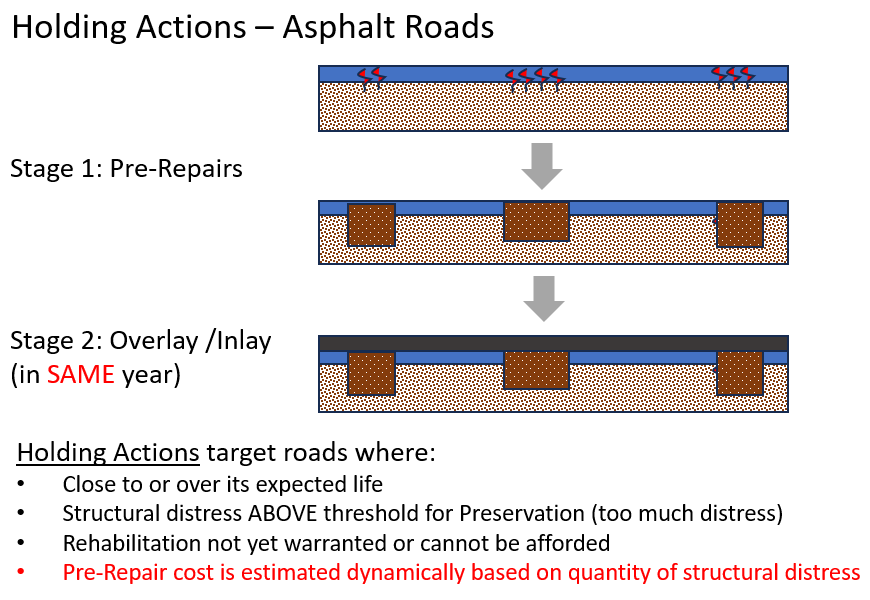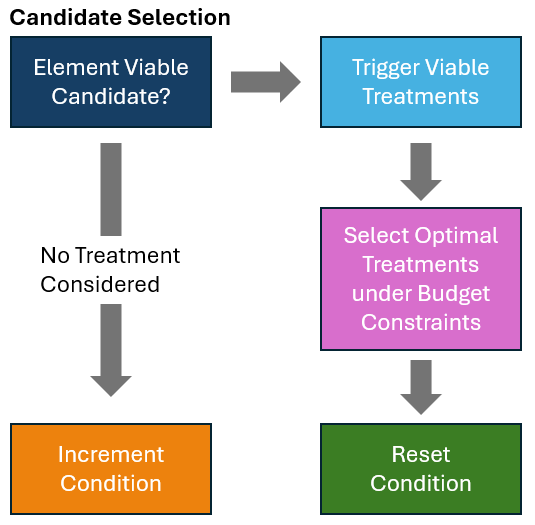Treatments Overview
Introduction
On this page, we provide details of the Treatment Types that are considered in the Default Juno Cassandra Road Deterioration model. Different sections discuss the following aspects:
- Which types of treatments are considered, and for which conditions
- How candidate treatments are selected to be considered in the optimisation stage
- What the impact of the various treatments are on the predicted condition.
More information about each treatment type can be found in the individual pages (linked on the left) that provide more detailed information about each Treatment Type.
Treatment Categories
The Category assigned to each treatment is what determines the underlying maintenance strategy that involves each treatment. The treatment category also determines how the treatment will resets existing distress when the treatment is applied.
The following Treatment Categories are handled in the Default Juno Cassandra Road Deterioration model:
- Preservation/Resurfacing Renewal
- Rehabilitation
- Holding Action
- HeavyMaint
Preservation/Resurfacing Renewal Treatments
Preservation or Surface Renewal Treatments are those treatments that are applied mainly as a preventative maintenance measure. These are treatments that are placed to ensure that the pavement surface remains safe, durable and waterproof. Preservation treatments are thus NOT placed to fix distresses but to prevent distresses from developing and extend the life of the pavement structure.

Preservation plays a critical role in proper Asset Management and the extent of preservation treatments included in the Forward Works Plan (FWP) can be seen as a measure of the health and maturity of the resource planning component of the Asset Management task or system.
Under some funding schemes, ‘Preservation’ may be defined as Routine Maintenance activities such as cleaning of drains, crack sealing while Resurfacing is regarded as ‘Renewal’. Note that, in this Cassandra Default Road Network model, Resurfacing is placed under the ‘Preservation’ category while routine maintenance activities are placed in a separate category deemed to be included in the specified Routine Maintenance treatment.
Rehabilitation
This treatment category aims to significantly restore the pavement structure to its original functional condition. This includes restoration or replenishment of the pavement structural capacity.
The Cassandra Default Road Network model allows for several classes of rehabilitation to acknowledge the differences in treatment cost and intensity for High, Medium and Low traffic classes. The model also distinguishes between rehabilitation for Asphalt-and-Chipseal-surfaced roads.
Holding Action
Holding actions serve as an intermediate step between Preservation and Rehabilitation. This treatment category addresses the following situations:
- Pavement distress is not sufficient to warrant a rehabilitation but too extensive to perform a Preservation/Resurfacing treatment.
AND/OR
- There is not sufficient funding to perform a rehabilitation, and therefore a Holding Action is placed to mitigate deterioration and keep the pavement at an acceptable level of service.
Achieving an optimal balance between Preservation, Rehabilitation and Holding Action treatments is one of the primary tasks of Infrastructure Deterioration Models. In Cassandra, there are two optimisation approaches to help with achieving an optimal balance between the different treatment categories. You can read more about these two approaches at this Cassandra documentation page in the Juno Cassandra documentation.

For Chip Sealed pavements, the Pre-Seal repairs and the Reseal takes place in consequetive years, as shown in the figure above.
For Asphalt surfaced roads, the Pre-Overlay repairs and the Overlay/Inlay takes place in the same year as shown in the figure below:

HeavyMaint
Heavy Maintenance treatments are applied in conjunction with Holding Actions, but are placed in a separate category so that they do not inflate the quantity of Holding Actions during reporting. There are two types of Heavy Maintenance:
PreSeal which are pre-seal repairs carried out in the year before a holding seal is placed.
HMaint_AC which are heavy maintenance repairs carried out during (i.e. in the same period) the placement of an Asphalt overlay.
Why is HeavyMaint not classified with Holding actions? The repairs done as part of a Reseal or an asphalt overlay typically comprise a subset of the full treatment length. Placing HeavyMaint and Holding actions in the same category, creates difficulties when the analyst wants to report on the quantity of Holding actions performed during different modelling periods.
This is easiest to understand in the case of an Asphalt Overlay with HeavyMaint. Take for example an element that is 100 metres long on which 30% repairs will be carried out before placing the overlay to repair weak areas to soft to sustain an overlay.
If the 30 m of HeavyMaint is given the same category as the overlay that is placed with it, then it would appear that the total length of Holding treatment for that element is 130m - thereby overstating the actual quantity and cost on which a Holding action was performed.
The same logic applies to Pre-Seal repairs performed the year before a holding seal is placed. Adding the two treatments together will overstate the quantity/cost that is classified as Holding seal.
Thus, although HeavyMaint form part of a Holding Treatment, the repairs are classified under a different category for reporting purpuses. This also makes it easy to clearly track the overall spending related to heavy repairs.
HeavyMaint are also given a separate Budget category called “Pre-Repairs” to reflect the fact that many Authorities have a separate budget for heavy maintenance.
Treatment Selection
The selection of treatments is a multi-stage process, as shown below:

Stage 1: Candidate Selection Logic
In this first stage of treatment selection, we select any viable candidates elements to be potentially treated in the current year. This selection is made based on age, condition and other parameters.
Note that, in this stage, there is no consideration of the treatment to be applied. We simply consider which network elements are to be considered as candidates for treatment. The main purpose of the Candidate Selection function is to reduce the number of elements put forward into the optimisation process, thereby significantly reducing model run time.
A more detailed discussion of the rules for Candidate Selection can be found on the page dealing specifically with Candidate Selection.
Stage 2: Triggering of Treatments
In this stage, the model gathers information on the elements selected by the Candidate Selection stage. The rules and processes used in the triggering of treatments depends on the type of optimisation mnodel being used.
For an MCDA Optimisation model, the trigger process checks element condition and surface features to determine which treatments are suitable to put forward to the optimisation process. Key to the MCDA treatment trigger process is the calculation of a ‘Treatment Suitability Score’ which serves as a relative indication of how fit-for-purpose each treatment is to the current condition of the element.
For a BCA Optimisation model, a set of long term strategies are selected based on element condition. The set of treatment strategies for the element is then added to the overall set of strategies to compete with the corresponding strategies of other elements in the optimisation stage.
Stage 3: Optimised Treatment Selection
In this final stage of treatment selection, the selected optimisation algorithm (MCDA or BCA) is used to select the optimal set of treatments to satisfy the budget constraints. Both the MCDA and BCA optimisation algorithms strive to select a set of treatments that will maximise the benefit while adhering to the constraints of the selected budget.